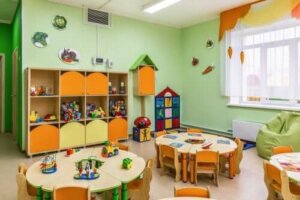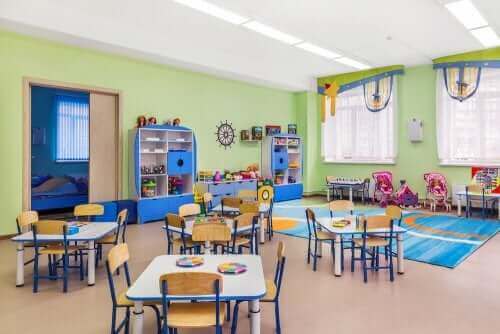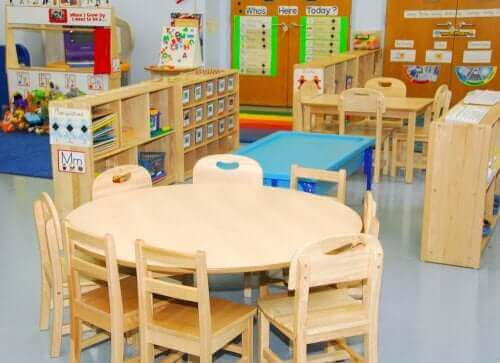The Davopsi Method for Classroom Organization


Written and verified by the pedagogue and trainer María Matilde
Davopsi is an acronym that stands for (in Spanish) Device for the Analysis and Evaluation of the Pedagogical Organization of Nursery Schools. And the Davopsi method aims to assess the quality of organization in the educational space. Its objective is to be able to visualize and analyze different dimensions of the school space in a way that allows for the detection of positive and negative aspects that can influence the learning processes.
The school space in the Davopsi method
The Davopsi method states that the organization of a school space will determine how the educational activities will be. Therefore, educators should always organize their space in a way that helps to develop significant educational experiences. In other words, in a way that covers all the basic needs or demands of students, mainly in the infancy stage.
According to the method, the school space must be a constant source of stimuli for the children. What’s more, it must always respect the characteristics of each student. And, at the same time, it must provide them with a safe, familiar, and emotionally balanced environment.
Spatial dimensions according to the Davopsi method
The method focuses on three dimensions that make up the education space, both inside and outside the classroom. These dimensions are:

Environment
It must respect children’s basic needs. What’s more, it must allow them to have educational experiences that help them acquire knowledge.
Thus, in interior spaces such as the classroom, the method advocates for different activity corners. These should encourage educational experiences related to the development of symbolic play and language and communication skills.
Also, there should be activities that promote motor and physical development, and others to work on reading, tactile, and visual skills. And of course, there should also be corners or areas dedicated to rest and relaxation.
At the same time, it’s important to consider other indoor spaces. For example, the library, the gym, the multipurpose room, or the assembly hall. That’s to say, these are spaces that can have additional uses. And, according to a good spatial organization and activity planning, they can become spaces with real educational potential.
When it comes to structuring outdoor spaces, these must allow children to play and move. Here, children must have opportunities to manipulate objects, experiment and observe. And they must always do so through constant communication and socialization among one another.
In addition, the evaluation of exterior spaces takes into account other dimensions as well. For example, the conditions that provide children with necessary contact with vegetation and green spaces. And, of course, basic protection and security measures are also an important consideration.
Privacy
This dimension is related to the way children work. Whether they do it alone or meet in groups or teams, their privacy must be guaranteed. That is, spaces must allow them to develop their activities in an orderly and quiet way, avoiding all kinds of conflicts that may arise between them.
Objects
When evaluating the classroom space, it’s essential to consider this dimension related to the existence of specific objects. That is, different objects belonging to the children should exist within the classroom. For example, photos of each one of them and their relatives, or of their pets. Even toys or other objects from their homes that help draw a connection with their family environment.

The development of autonomy and the role of adults in school spaces according to the Davopsi method
As we’ve mentioned, this method is a tool that allows us to appreciate the significant aspects of the pedagogical organization of nursery schools. And we’ve seen the dimensions that it addresses in evaluating the school space. However, the method also focuses on the role of adults and the need for children to be increasingly autonomous.
The role of adults in the organization of school spaces is fundamental. This is because teachers are the ones who guide and mediate so that the children understand the rules regarding those spaces. In addition, they’re the ones who must generate adequate environments of warmth and inclusion so that children develop a sense of belonging and security.
In terms of encouraging children’s autonomy, the correct organization of educational spaces is fundamental. If children are capable of establishing a safe and comfortable relationship with the spaces and environments that surround them, they’ll be able to become more autonomous.
Therefore, the spaces shouldn’t contain dangerous objects. Also, they should be large and open, well lit, and warm. And, above all, they should be spaces that invite children to make free and enjoyable use of them.
Davopsi is an acronym that stands for (in Spanish) Device for the Analysis and Evaluation of the Pedagogical Organization of Nursery Schools. And the Davopsi method aims to assess the quality of organization in the educational space. Its objective is to be able to visualize and analyze different dimensions of the school space in a way that allows for the detection of positive and negative aspects that can influence the learning processes.
The school space in the Davopsi method
The Davopsi method states that the organization of a school space will determine how the educational activities will be. Therefore, educators should always organize their space in a way that helps to develop significant educational experiences. In other words, in a way that covers all the basic needs or demands of students, mainly in the infancy stage.
According to the method, the school space must be a constant source of stimuli for the children. What’s more, it must always respect the characteristics of each student. And, at the same time, it must provide them with a safe, familiar, and emotionally balanced environment.
Spatial dimensions according to the Davopsi method
The method focuses on three dimensions that make up the education space, both inside and outside the classroom. These dimensions are:

Environment
It must respect children’s basic needs. What’s more, it must allow them to have educational experiences that help them acquire knowledge.
Thus, in interior spaces such as the classroom, the method advocates for different activity corners. These should encourage educational experiences related to the development of symbolic play and language and communication skills.
Also, there should be activities that promote motor and physical development, and others to work on reading, tactile, and visual skills. And of course, there should also be corners or areas dedicated to rest and relaxation.
At the same time, it’s important to consider other indoor spaces. For example, the library, the gym, the multipurpose room, or the assembly hall. That’s to say, these are spaces that can have additional uses. And, according to a good spatial organization and activity planning, they can become spaces with real educational potential.
When it comes to structuring outdoor spaces, these must allow children to play and move. Here, children must have opportunities to manipulate objects, experiment and observe. And they must always do so through constant communication and socialization among one another.
In addition, the evaluation of exterior spaces takes into account other dimensions as well. For example, the conditions that provide children with necessary contact with vegetation and green spaces. And, of course, basic protection and security measures are also an important consideration.
Privacy
This dimension is related to the way children work. Whether they do it alone or meet in groups or teams, their privacy must be guaranteed. That is, spaces must allow them to develop their activities in an orderly and quiet way, avoiding all kinds of conflicts that may arise between them.
Objects
When evaluating the classroom space, it’s essential to consider this dimension related to the existence of specific objects. That is, different objects belonging to the children should exist within the classroom. For example, photos of each one of them and their relatives, or of their pets. Even toys or other objects from their homes that help draw a connection with their family environment.

The development of autonomy and the role of adults in school spaces according to the Davopsi method
As we’ve mentioned, this method is a tool that allows us to appreciate the significant aspects of the pedagogical organization of nursery schools. And we’ve seen the dimensions that it addresses in evaluating the school space. However, the method also focuses on the role of adults and the need for children to be increasingly autonomous.
The role of adults in the organization of school spaces is fundamental. This is because teachers are the ones who guide and mediate so that the children understand the rules regarding those spaces. In addition, they’re the ones who must generate adequate environments of warmth and inclusion so that children develop a sense of belonging and security.
In terms of encouraging children’s autonomy, the correct organization of educational spaces is fundamental. If children are capable of establishing a safe and comfortable relationship with the spaces and environments that surround them, they’ll be able to become more autonomous.
Therefore, the spaces shouldn’t contain dangerous objects. Also, they should be large and open, well lit, and warm. And, above all, they should be spaces that invite children to make free and enjoyable use of them.
All cited sources were thoroughly reviewed by our team to ensure their quality, reliability, currency, and validity. The bibliography of this article was considered reliable and of academic or scientific accuracy.
- Medrano Escudero, A. (2013). Análisis de la organización del espacio escolar en la etapa de Educación Infantil. Un estudio de caso. Recuperado de http://uvadoc.uva.es/bitstream/handle/10324/4776/TFG-L328.pdf?sequence=1&isAllowed=y
- Ledesma Aragón, C. (2012). Uso y distribución de espacios escolares. Trabajo de fin de Grado Escuela Universitaria de Educación de Palencia. Universidad de Valladolid. Recuperado de https://uvadoc.uva.es/bitstream/handle/10324/2911/TFG-L155.pdf?sequence=1
- Zabalza, M. (2010). Didáctica de la Educación Infantil. Editorial Narcea. Madrid.
This text is provided for informational purposes only and does not replace consultation with a professional. If in doubt, consult your specialist.








